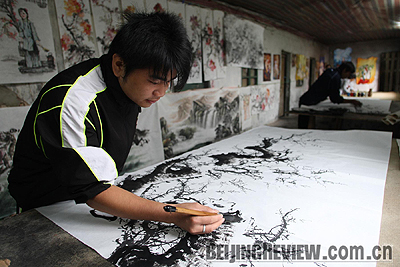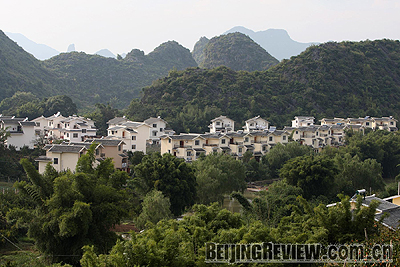|
|

LOCAL TALENT: A young man paints at an artist workshop in Wutong Township, Guangxi. The town has 800 people engaged in the art business and is home to 20 art workshops (DUAN WEI) |
The core of China's rural issues is how to help farmers earn a good living. In Guangxi Zhuang Autonomous Region in southwest China, this issue is particularly relevant, as 80 percent of the population lives in the countryside.
"We have received 30 tourists in the morning and another dozen will check in later," Rong Tao told reporters at the balcony of her home. "We had a gross revenue of 5,000 yuan ($724) last weekend, and the profit was 3,000 yuan ($434) at least."
Rong, a farmer in Hongyan Village in Gongcheng Prefecture, Guangxi, has made a good living by developing ecological agriculture. Her village has the reputation of being the richest in Guangxi, as the majority of people are comfortably well off.
Statistics from the local government show that the per-capita income in the village exceeded 9,000 yuan ($1,304) in 2007, threes times the local average. Some families make a yearly income of as much as 200,000 yuan ($29,000).
|

GREEN IDEA: The villagers of Hongyan in Gongcheng Prefecture, Guangxi, have made a good living through developing ecological tourism (DUAN WEI) | Two decades ago, the village was poverty-stricken, but since the 1990s farmers were encouraged to grow a certain kind of persimmon, which later developed into a flourishing pillar industry.
Forty-three-year-old Zhu Minglun sought jobs in other parts of the country before even finishing middle school, but ended up back in the village doing farm work. Now he grows persimmons with an annual output of 35,000 kg, which contributes to a yearly income of 40,000 yuan ($5,800). Along with other income, his family makes about 100,000 yuan ($14,000) a year.
"The land used to be left wild, but now it has all been reclaimed and used to grow persimmons," said Zhu. He used to grow crops like rice and corn, but the income from them was poor, while growing persimmons brings in $14,000 per hectare.
At the end of 2002, with the support of the local government, Hongyan Village began to develop tourism. The village was relocated and rebuilt in a scenic spot with trees and a river. Roads were also built to link every household.
Agricultural tourism has worked so well that at peak times during September and December visitors have to make advance reservations if they want to find a room.
Rong has six guest rooms in her house, each with two beds, a television set, air conditioners, and a bathroom. She charges a fair rate of 80 yuan ($11) a night.
Nowadays tourism is the main source of her family's income. Rong and her husband took a cooking course to attract tourists with their culinary skills and at peak times hire staff to help out.
Artistic farmers
In Wutong Town, Lingui County, local farmers have turned art into an international business.
|
